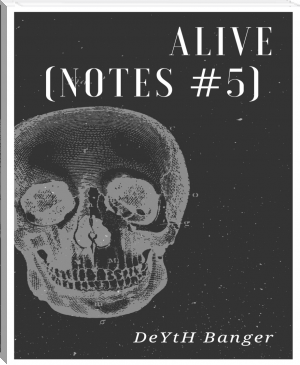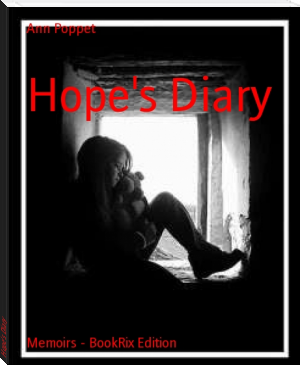Diary 2 by DeYtH Banger (best time to read books .txt) 📖

- Author: DeYtH Banger
Book online «Diary 2 by DeYtH Banger (best time to read books .txt) 📖». Author DeYtH Banger
“If you’re in a lighter stage of sleep you’d be more attuned to any kind of threat in the environment,” says coauthor Charlie Nunn, professor of evolutionary anthropology at Duke.
Previous studies have found similar patterns in birds, mice, and other animals, but this is the first time the phenomenon has been tested in humans, Samson says.
The misaligned sleep schedules were a byproduct of changing sleep patterns common with age, researchers say. Participants in their 50s and 60s generally went to bed earlier, and woke up earlier than those in their 20s and 30s.
The researchers call their theory the “poorly sleeping grandparent hypothesis.” The basic idea is that, for much of human history, living and sleeping in mixed-age groups of people with different sleep habits helped our ancestors keep a watchful eye and make it through the night.
“Any time you have a mixed-age group population, some go to bed early, some later,” Nunn says. “If you’re older you’re more of a morning lark. If you’re younger you’re more of a night owl.”
The researchers hope the findings will shift our understanding of age-related sleep disorders.
“A lot of older people go to doctors complaining that they wake up early and can’t get back to sleep,” Nunn says. “But maybe there’s nothing wrong with them. Maybe some of the medical issues we have today could be explained not as disorders, but as a relic of an evolutionary past in which they were beneficial.”
Treating ADHD may lower risk of drug trouble
by Kevin Fryling-Indiana

For teens and adults with attention deficit hyperactivity disorder (ADHD), using medication to treat the condition may significantly reduce the risk for drug and alcohol abuse.
The risk of substance use problems during periods of medication use was 35 percent lower in men and 31 percent lower in women in the study. The results, which appear in the American Journal of Psychiatry, are based upon nearly 3 million people with ADHD in the United States.
“This study contributes to growing evidence that ADHD medication is linked to lower risk for many types of harmful behavior, including substance abuse,” says Patrick D. Quinn, a postdoctoral researcher in the Indiana University Bloomington College of Arts and Sciences’ psychological and brain sciences department, who led the study. “The results also highlight the importance of careful diagnosis and compliance with treatment.”
As one of the largest analyses on the risks and benefits of ADHD medication, the study drew on anonymous health care data from 146 million people with employer-based health insurance in the United States from 2005 to 2014.
Specifically, the researchers mined the data to identify people with ADHD whose records showed periods of ADHD medication use and periods without ADHD medication use—as well as one or more visits to the emergency room due to drug or alcohol use. They then calculated the odds of the visits occurring during the person’s use of ADHD medication versus the same person’s non-use of ADHD medication.
“Many factors can influence who receives ADHD treatment, including socioeconomic factors, health care access, the strength of support networks, and disorder severity,” Quinn says.
“Although no single study of real-world treatment practices can definitively show whether medication use lowers risk, studying the same people at different points in their medical history helps us control for these factors and isolate the role of medication in their behavior,” he says.
Of the nearly 3 million people with ADHD in the study’s database, about 57 percent experienced periods in which they were and were not prescribed medication to treat the disorder. About 2 percent experienced an emergency room visit due to substance abuse. The median age of the study’s participants was 21 for men and 28 for women.
The majority of the ADHD medicines used in the study were stimulants such as Adderall, an amphetamine, and Ritalin, or methylphenidate. A significantly smaller number used nonstimulant ADHD medication such as Strattera, or atomoxetine.
“While concerns about prescribing medications to treat ADHD that have the potential for abuse are understandable, this study provides further evidence that the use of these medications is not associated with increased risk of substance use problems in adolescence or adulthood,” Quinn says. “Rather, this and other recent studies find that the risk of such problems is lower during and after periods of use of these medications.”
Another study from this group in the lab of Brian M. D’Onofrio recently reported in JAMA Psychiatry found that the use of ADHD medication was associated with lower risk of motor vehicle accidents in men and women.
D’Onofrio is also a coauthor of several studies based on patient data from Sweden that found similarly lower risk for substance abuse and transport accidents in people with ADHD who used medication.
The larger number of people in the two more recent studies—as well as the use of US patients in the new analyses—strengthens this earlier evidence.
“Together, these studies provide accumulating evidence about the possible short- and long-term benefits of ADHD medications,” says D’Onofrio, a professor in the psychological and brain sciences department. “They also provide important information to medical providers who prescribe ADHD medication—as well as to adults with the disorder and parents trying to make medical decisions for children. Overall, I think people should find these results reassuring.”
When 1 depression med doesn’t work, add another?
by Bill Hathaway-Yale

Millions of patients suffering from major depression get little relief from the first drug they take. A new study of 1,522 patients at 35 US Veterans Health Administration medical centers shows these patients benefit more from adding an antidepressant treatment than from switching to another one.
“We found that among three strategies evaluated in this study evidence of the greatest symptom benefit was provided by adding an antipsychotic to previous antidepressant therapy,” says lead author Somaia Mohamed, associate clinical professor of psychiatry at Yale University School of Medicine and of the VA Connecticut Healthcare System, West Haven, Connecticut.
Less than a third of 16 million Americans with major depression obtain relief of symptoms from the first drug prescribed.
Findings of the study in the Journal of the American Medical Association show a remission rate of 28.9 percent of those who augmented initial treatment with the antipsychotic drug aripiprazole (Abilify) after 12 weeks—significantly greater proportion than the 22 percent remission among patients who discontinued use of one antidepressant and switched to another (buproprion).
The group taking aripiprazole was also significantly more likely to show a clinically meaningful response to treatment than either switching to another antidepressant or adding another antidepressant to the original medication.
“The study by Mohamed and colleagues…suggests that that all options are not alike,” says John Krystal, professor and chair of the Yale Department of Psychiatry. “This study provides the type of detailed guidance that doctors need.”
Chapter 5Creepy Shit
1 by 1
2 by 2
3 by 3
4 by 4





Comments (0)